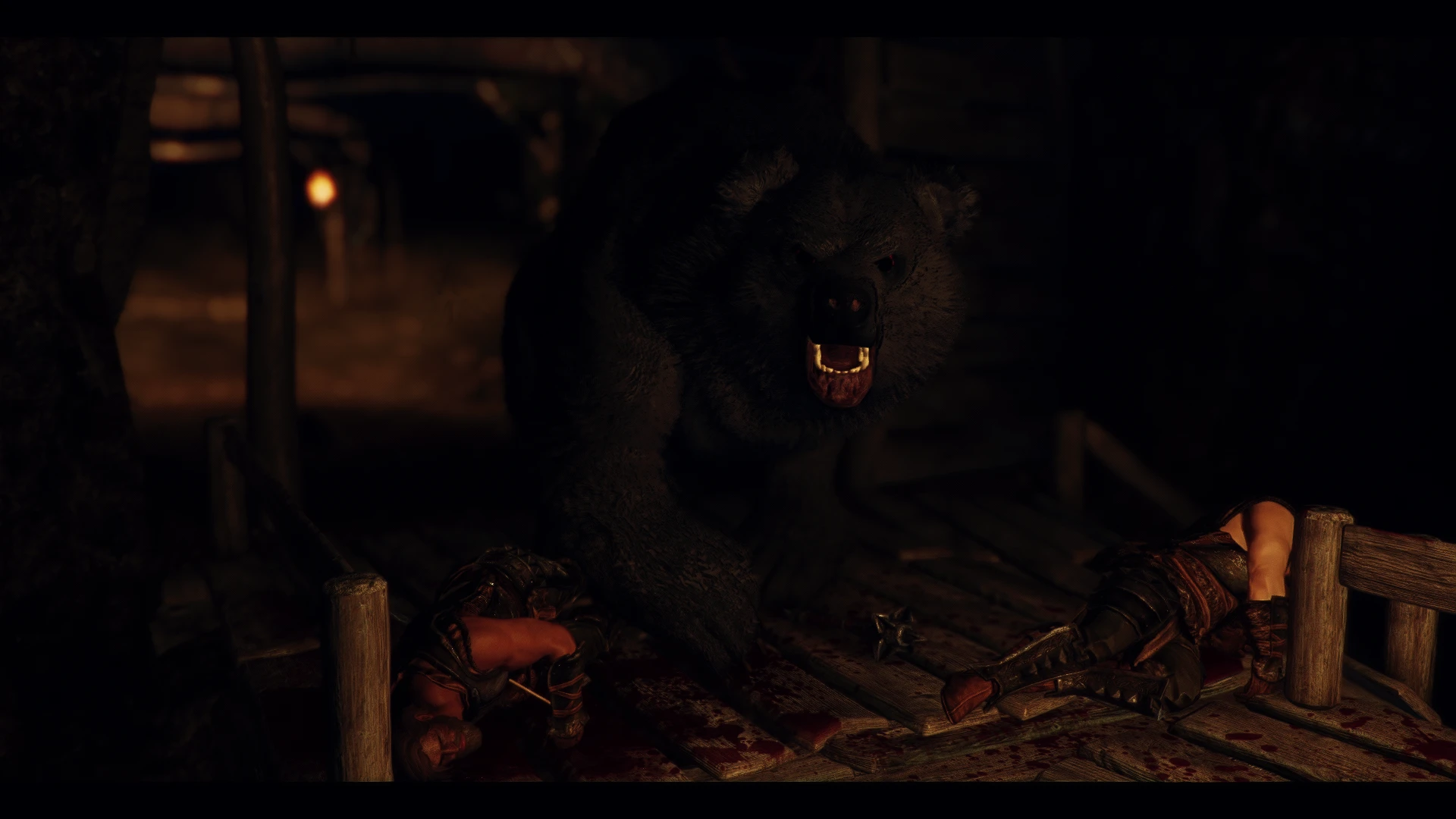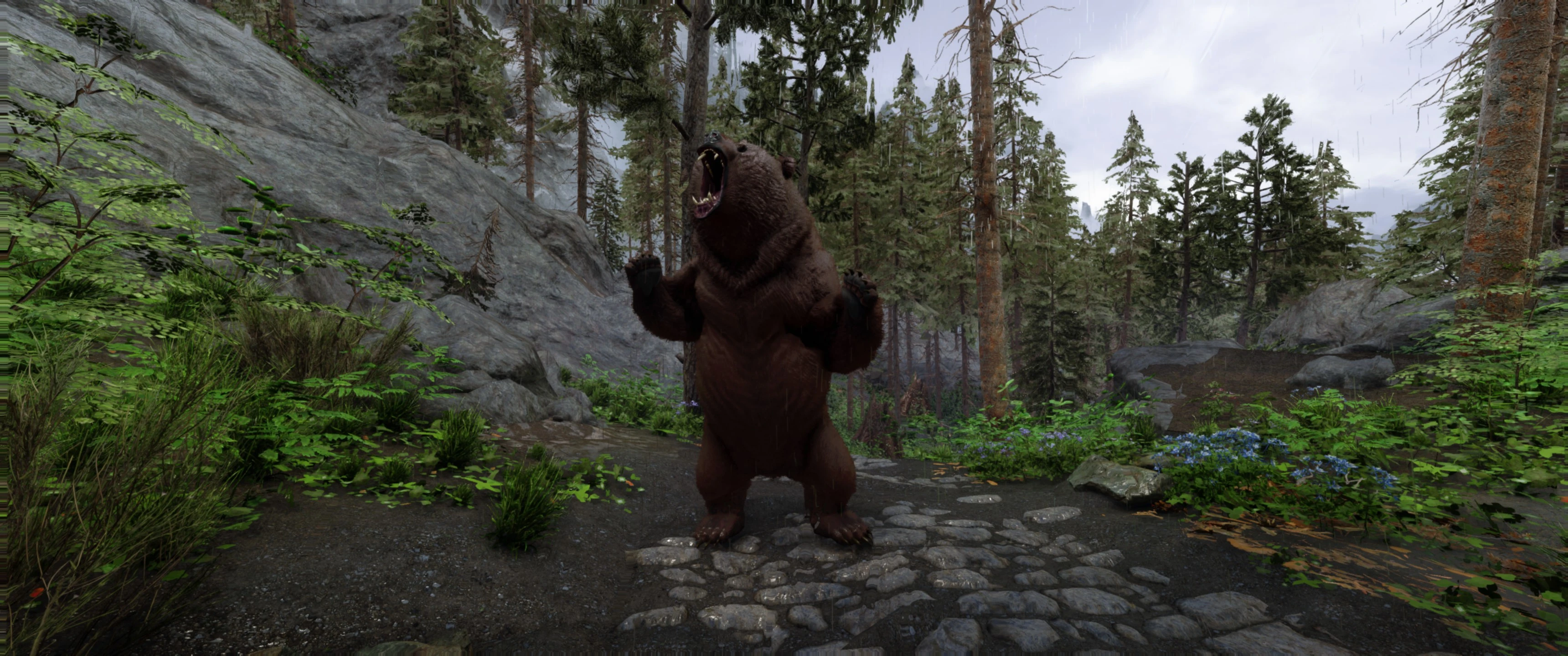North Arkaelian Direbear
Compared to prehistoric bear species, modern bears are relatively tame. Then again, today’s earth bruins don’t have to carve out territory from other terrifying predators such as saber-toothed cats, packs of dire wolves, cave lions, and even massive carnivorous, cow-sized pigs that were more likely to charge you—and eat you—then run away. However, on Arkael. . that may not be the case anymore. . .First documented by explorers traveling north on a fur trade route, but now reported primarily among the land’s more wooded northern regions, The Northern Arkaelian Dire Bear, is an imposing yet surprisingly interesting creature. Fairly widespread but uncommon, this animal has survived this far by being reclusive: less than three dozen sightings are reported on average annually, which for it’s amazing size, is actually really impressive. and much like its unintentional extinct namesake, what is known about it has it living in very ill repute.
Appearance
Resembling a grizzly bear in appearance, the North Arkaelian Dire Bear is distinguishable from many other bear species, by its much shorter snout and more robust build, earning it the nickname ”Short-Faced Bear." To many living in Arkael, it is also commonly called the Dire Bear, a name which is appropriate, considering that much like on Earth its large size makes it considered to be one of the biggest known terrestrial mammalian carnivores ever known on Arkael, allowing this creature the same stardom as the now extinct Short-faced Bear of Earth. How this particular bear species came to be is unknown, but theories suggest a surprising, evolutionary history fueled by the mixed species interbreeding of large bear species. Its well known that all the Ursinae species (i.e., all bears except the giant panda and the spectacled bear) appear able to crossbreed, leading to hybrids such as the Grizzly–polar bear hybrid and the Kodiak × polar bear hybrid aka “The Grolar Bear" And it is well known that Arkael shares around half of the bear species that Earth does, especially Polar and Grizzly. Though it is unclear as to what possible species mixing established this creature, the mark it left in it’s wake is well known. One of the largest and most unique of all bears that now rule Arkael wild-area's, it is differentiated from the modern Arkael brown bears and grizzlies by the more distinctive “bulldog” like facial structure. Adult Males can stand 13-16 ft tall. When walking on all fours, they stand about 7 in half to almost 8 feet high at the shoulder and are tall enough to look an adult human in the eye looking down. The largest individuals of this species are estimated to have weighed more than 3,600 lb) with the largest recorded animal ever killed being 4,200 pounds. For comparison, an adult male grizzly weighs about 600. An adult male polar bear weighs around 775 to 1,200 lbs with the largest polar bear recorded weighing 2,209 pounds (1,000 kg), according to Polar Bear International. Females weigh half as much as their male counterparts, at only 330 to 650 lbs. Its skull and shearing type of teeth indicates a highly carnivorous way of life. Its eye sockets are set wide apart and face forward, giving it excellent vision. Its short, broad snout had a huge nasal passage, which means it had a keen sense of smell and the ability to inhale great volumes of oxygen while pursuing prey. The large width of the jaws in relation to their shortness, plus the huge insertions for biting muscles, gave this bear a vise-like killing bite and the ability to crush bones to obtain marrow.Diet
The Arkael Dire-Bear is a hellish and brutish predator that can overwhelm the megafauna of its home range with its great physical strength. The bear is opportunistic with staples of berries, leaves, roots and tubers, fish, nuts, and small animals all eagerly eaten, but it is a craving for red meat that makes this giant bear so famous …and so dangerous. Hunting techniques vary between home-range. Those living in more arctic area's or coastal areas hunt their prey in several different ways. When a bear spots a seal hauling out on the sea ice, it slowly stalks it with the head and neck lowered, possibly to make its dark nose and eyes less noticeable. As it gets closer, the bear crouches more and eventually charges at a high speed, attempting to catch the seal before it can escape into its ice hole. Some stalking bears need to move through water; traversing through water cavities in the ice when approaching the seal or swimming towards a seal on an ice floe. Despite its sheer size, they are remarkable swimmers, and can stay underwater with its nose exposed. When it gets close enough, the animal lunges from the water to attack. Other bears learn hunting by provoking animal's into stampeding, and then look for young that have been crushed or separated from their mothers during the turmoil. They are also adept scavengers and kill-stealers; using their highly attuned sense of smell these bears can travel great distances in search of carrion, relying on their huge size and strength to scare off other carnivores. The diets of Arkael Dire's also vary extensively based on seasonal and regional changes. Those who live more Inland instead of coastal are famous due to them being the only animals next to wargs willing and brave enough to take down healthy Male Winsets. They often rely on raw power when trying to kill their prey, and will employ bites or paw swipes particularly to the neck and flank in order to take down prey. Even large game like bison can be taken down, killed with a decisive crunching bite to the neck or brain-case, with its shorter snout aiding in allowing the creature to hold on without having to let go on occasion to breathe through it’s nose while it’s mouth is full. Much like Grizzlies, they are also surprisingly fast for their size, chasing down their prey which tends to be herbivorous mammals and dinosaurs. They can run as fast as horses but are unable to make sharp turns, so they usually hunt out in more open areas. One of the most interesting aspects in their behaviors is their habit of frequently stealing game from snare traps and they have even been known to follow hunters until they make a kill, which is why many refer to them as “kill-sitter bears”. Wilderness adventurers frequently cross paths with bears but it is the Dire Bear variety that inspires the most fear and awe in their campfire stories; for if the tales are true, then some of these animals have become quite accomplished man-eaters. . .Breeding
The reproductive habits of Dire bears are poorly understood at this time, but so far there’s no evidence suggesting that their breeding habits are any different from those of other bear species native to Arkael. What is noted is as follows- Males often search for females in estrus by traveling in twisting paths which reduces the chances of them encountering other males while still allowing them to find females. The movements of females remain linear and they travel more widely. The mating system can be labeled as female-defense polygyny, serial monogamy or promiscuity.
- From what has been observed, upon finding a female, a male will try to isolate and guard her. Courtship can be somewhat aggressive, and a male will pursue a female if she tries to run away. It can take days for the male to mate with the female which induces ovulation. After their first copulation, the couple may bond. Undisturbed pairings typically last around two weeks during which they will sleep together and mate multiple times.
- Competition for mates can be intense and this has led to sexual selection for bigger males. While males will try NOT to engage in fighting at the risk of serious injuries, Males often have scars or other injuries from fighting.
- A female mates with multiple males in a season and as a result it is often hypothesized that a single litter can have more than one father.
Fur Variant Types
Although variable in color from blond to nearly black, Dire-Bear fur is typically brown with darker legs and commonly white or blond tipped fur on the flank and back. However over the years many fur variant types have been discovered throughout the species similar to that of other bears. The color of the Dire coat varies from nearly white to variations of brown to reddish to dark brown, even black.Trivia
- Dire Bears do not Hibernate, but Migrate, following herds on their seasonal migration pathways during the winter. In fact some bears will often make seasonal dens on "Animal Highways" in order to hunt prey during winter months, before returning back to their original territory.
- Despite being the fastest bear, their legs are not used for sharp turns while sprinting, it would potentially break its leg if it attempted to do so. They can run as fast as horses but are unable to make sharp turns, so they usually hunt out in more open areas.
Classification
Domain: Eukaryota
Kingdom: Animalia
Phylum: Chordata
Class: Mammalia
Order: Carnivora
Family: Ursidae
Subfamily: Tremarctinae
Genus: Arctotherium
Species: Arctotherium gigus
Behavior Solitary, defensive
Habitat: Meadows, coastlines, forested areas, Redwoods, Boreal Valleys, Woodlands, Grasslands
Senses: Excellent sense of smell, keen senses overall
Social: Typically isolated from each other
Active: Active day and night, but rest during midday
Ranking: Megafauna (beast type)






Comments